3.3.4.2 mass transport in plants
1/52
There's no tags or description
Looks like no tags are added yet.
Name | Mastery | Learn | Test | Matching | Spaced |
|---|
No study sessions yet.
53 Terms
what is transpiration?
the evaporation of water from a plant’s surface, particularly through the stomata when they open to allow the entry of carbon dioxide for photosynthesis
what kind of factors is the rate of transpiration affected by?
external environmental factors related to the surrounding environment
+ by internal factors related to the structure of the plant
give the 4 environmental factors that affect the rate of transpiration
light
temperature
humidity
air movement
explain the effect of light on the rate of transpiration → at day and at night
during daylight, stomata open to allow carbon dioxide to enter for photosynthesis
this increases the rate of transpiration as water evaporates from the mesophyll
at night, no photosynthesis occurs, so the stomata begin to close
transpiration decreases due to closed stomata
explain the effect of temperature on the rate of transpiration
an increase in temperature increases the rate of transpiration by providing the water molecules with more kinetic energy allowing them to evaporate more readily
what is humidity?
humidity refers to the water vapour content of the air surrounding the plant
explain the effect of humidity on the rate of transpiration
an increase in humidity of the air increases the water potential of the air
this will lead to a decrease in the rate of transpiration, as the water potential gradient for the diffusion of water decreases
explain the effect of air movement on the rate of transpiration
air movement removes water vapour from the leaf surface increasing the water potential gradient + the rate of transpiration
in still air, water vapour builds up around the leaf decreasing the water potential gradient + the rate of transpiration
most plants possess what type of adaptations?
structural adaptations that reduce the rate of transpiration, many involving adaptations of leaf structure
what are xerophytes?
plants that possess a range of adaptations to limit water loss via transpiration (decreased transpiration)
explain five adaptations xerophytes possess to decrease the rate of transpiration
a thick cuticle provides a long diffusion pathway, reducing the rate of evaporation
hairs on the leaf surface trap a layer of still air, which becomes saturated with water vapour, reducing the water potential gradient for water loss (as there’s an increase in humidity)
rolling up of leaves traps a layer of still air which becomes saturated with water vapour → this reduces the water potential gradient for water loss, reducing the rate of transpiration eg marram grass
reduced surface area to volume ratio of leaves eg pine needles reduce the surface area for water loss
stomata positioned in ‘epidermal pits or grooves’ beneath the leaf surface, reducing exposure to air currents → the trapped air become saturated with water vapour + reduces the water potential gradient for evaporation
where does the movement of water + dissolved ions occurs?
through the xylem
xylem is part of the ________ stream, which does what?
transpiration
which transports water from the root hairs to the stomata
what is the cohesion-tension theory used to explain?
the movement of water + mineral ions from roots to leaves in the xylem
describe + explain the structure of xylem in depth
the xylem tissue is dead so there are no cell contents → this leaves hollow tubes so that there is minimal resistance to the flow of water + ions
the cell wall is strengthened by lignin → this makes the cell walls more rigid + provides support
xylem tubes have no end walls
what does the cohesion-tension theory explain?
water transport in the xylem
describe the cohesion-tension theory
solar heat energy causes the evaporation/transpiration of water from leaves (out of the stomata) → this lowers the water potential of the air spaces in the leaf cells
water moves from cell to cell across the leaf by osmosis down a water potential gradient
water is drawn from the xylem, creating a tension (‘negative pressure’) in the xylem vessels effectively “pulling up” the water + dissolved ions
the water column is maintained in the xylem by cohesive forces + adhesive forces
cohesion refers to the attraction of the water molecules to each other by hydrogen bonding
adhesion refers to the attraction of the water molecules to the xylem walls
what is the advantage of the upward movement of the water from the xylem in the roots?
it maintains the water potential gradient across the root cells, providing the mechanism for water uptake from the soil via osmosis → soil has a higher WP than root hair cells so water moves into root cells by osmosis
describe the movement of water between the different structures in the leaf
some water moves from xylem to cell by osmosis for use in photosynthesis
water moves from cell to cell by osmosis
water moves from the cell wall to the sub-stomatal air space by evaporation
water moves from stomata to air by evaporation
explain the evidence for the cohesion-tension theory
as the rate of transpiration increases, the diameter of the tree trunk + branches decreases
evaporation of water from the leaves draws from the xylem by osmosis, water is pulled up the xylem creating a tension
the tension pulls in the walls of the xylem vessels so the overall diameter of the trunk + branches decreases
what can be used to measure the rate of transpiration?
a potometer
what assumption does the method of using a potometer use to measure the rate of transpiration?
the method assumes that the rate of water uptake is the same as the rate of transpiration
why is the assumption that the rate of water uptake is the same as the rate of transpiration not entirely valid?
some of the water taken up by the plant is often used to maintain turgidity (ie for support) + a small percentage is used in photosynthesis
what 3 measurements are required to measure the rate of transpiration (eg in cm³ hr⁻¹) when using a potometer?
the distance (d) the air bubble moves in cm
the time taken for the air bubble to move distance
the radius (r) of the lumen/bore of the capillary tubing
what equation is used to calculate the volume of water taken up?
πr²d
what must happen for the potometer to work properly? why?
there must be no air bubbles
if the column of water is broken + the cohesion is lost, the water will not be drawn up from the potometer
how can you ensure no air bubbles when using the potometer?
the rubber bung must provide an air-tight seal → can seal it with vaseline to make the air tight
it is also necessary to fill the potometer, cut the end off the shoot + insert the shoot into the potometer under water to prevent air entering
what does the reservoir allow you to do?
it makes it possible to push the bubble back to the beginning of the scale for repeat readings (it re-sets the bubble)
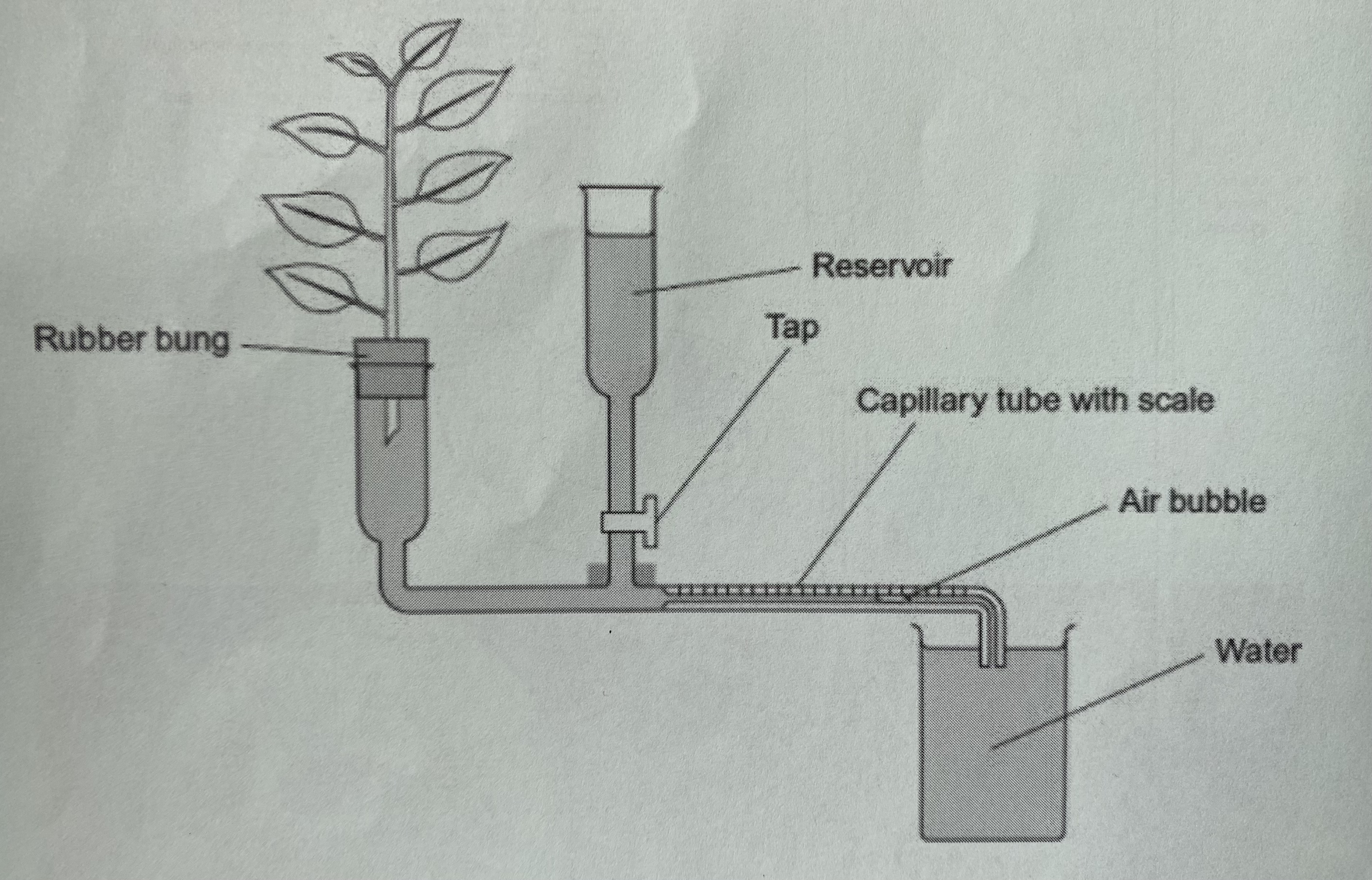
how could you change the method of using a potometer to investigate the effect of each of the 4 environmental factors that affect the rate of transpiration?
add vaseline to the leaf to change the thickness of the waxy cuticle
use a fan to create air currents
tie a transparent bag around the leaf to create humidity
use a lamp to change light intensity
what can be used to provide evidence that the transport of mineral ions through a plant occurs mainly in the xylem?
radioactive isotopes which can then be used as tracers

explain how radioactive isotopes can be used as tracers to provide evidence for the movement of ions in the xylem
xylem + phloem in a section of the stem of a plant are separated using a wax cylinder to prevent lateral (sideways) transport
roots of the plant are supplied with radioactively labelled potassium ions, ⁴²K
plant is left for a few hours + the amount of radioactivity in the xylem + phloem tissues in the region of the wax cylinder is then measured + compared
the amount of radioactivity in the xylem is considerably greater indicating that transport of the potassium ion occurs in the tissue

why is there still a relatively small mount of radioactivity in the phloem tissue? (when using radioactive isotopes to provide evidence for movement of ions in xylem)
this is due to lateral transport from the xylem in the region where the wax cylinder is not present
what is translocation + where does it occur?
the transport of photosynthetic products is known as translocation
it occurs in the phloem
what forms are _______ transported in?
a. carbohydrates
b. proteins
c. lipids
a. sucrose
b. amino acids
c. fatty acids + glycerol
describe how these organic molecules (sucrose, amino acids, fatty acids + glycerol…) are produced + transported in the plant
these organic molecules are produced in the leaves (known as the source) during photosynthesis + then transported up + down the stem of a plant to the sinks
give 3 examples of what the sinks can be
growing areas such as young leaves, shoot tips + root tips
the roots
developing fruits or storage areas (eg potatoes)
what is the purpose of the phloem?
it transports these photosynthetic products
what does the phloem consist of?
of living cells including sieve elements + companion cells
describe the in-depth structure of the phloem
sieve elements are joined end to end to form sieve tubes
the end walls of sieve elements are known as sieve plates as they possess pores
mature sieve elements do not possess a nucleus + the cytoplasm which is around the edge of the cell contains few organelles
next to each sieve element is a companion cell with dense cytoplasm + many mitochondria
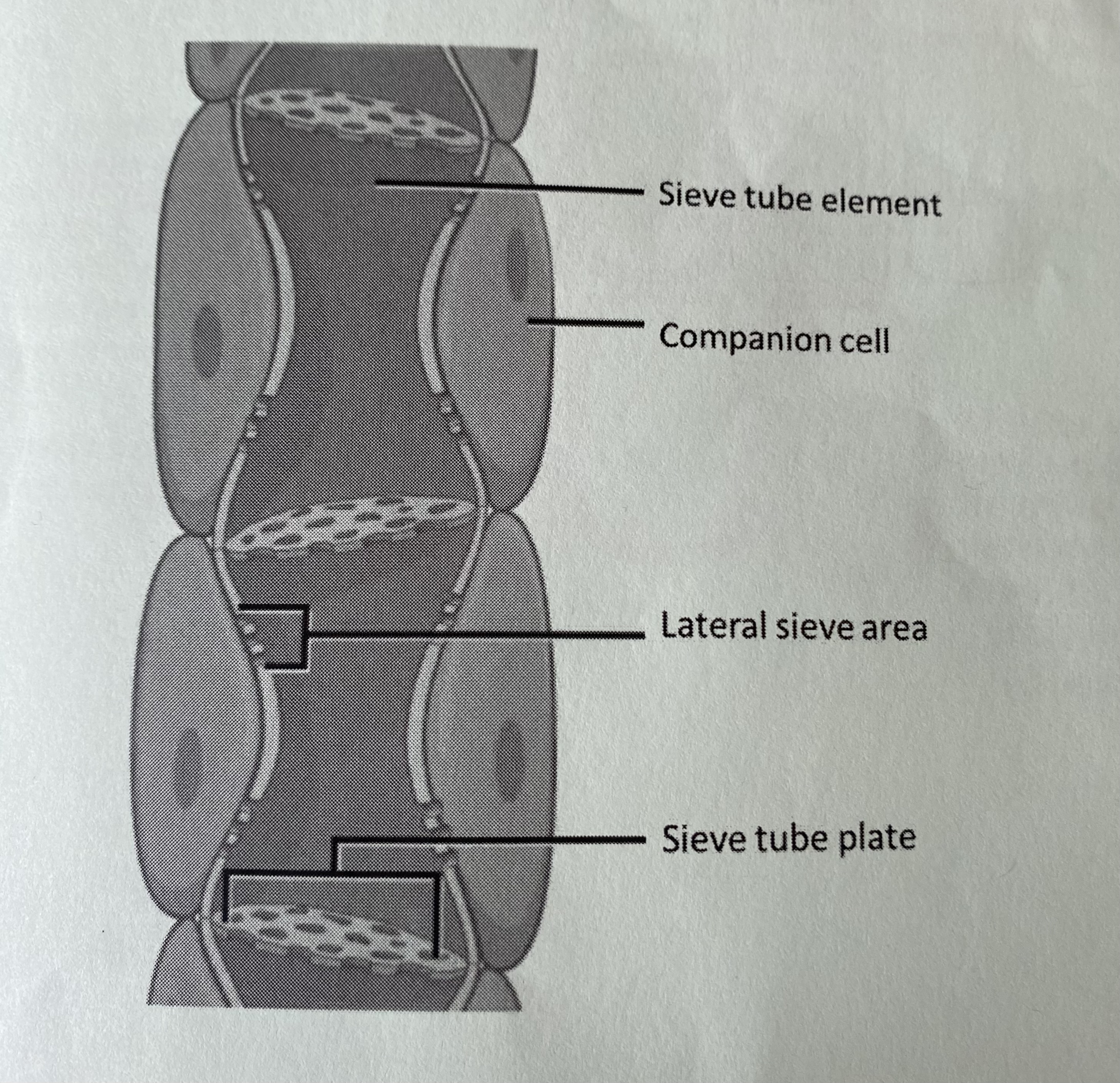
how is the phloem possessing a large amount of mitochondria an advantage?
it supplies lots of ATP (from respiration) for active transport
what is the main hypothesis for the method of translocation in phloem?
the mass flow hypothesis
outline the mass flow hypothesis
mass flow of organic substances is though to occur down a hydrostatic or turgor pressure gradient
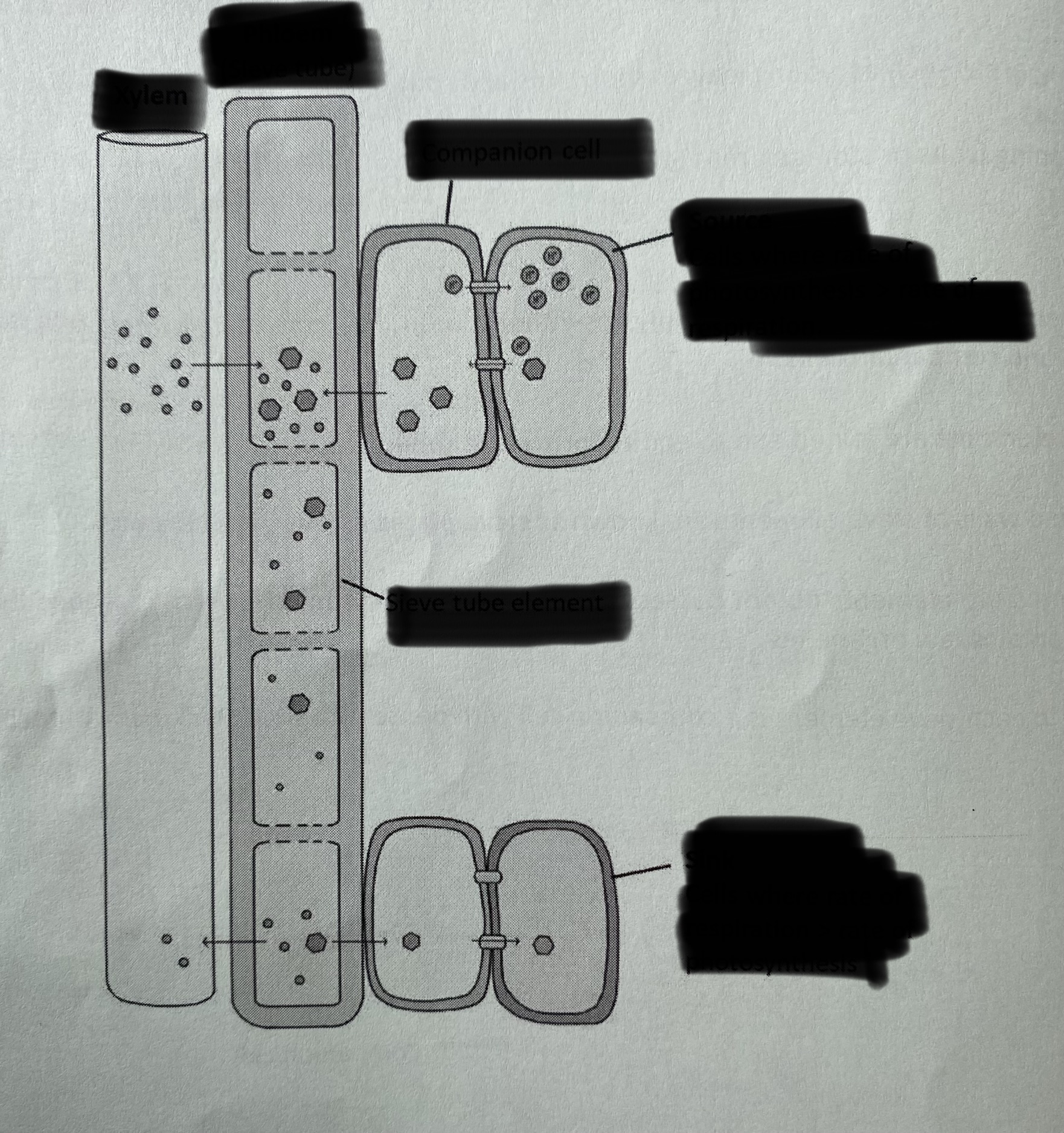
label the diagram
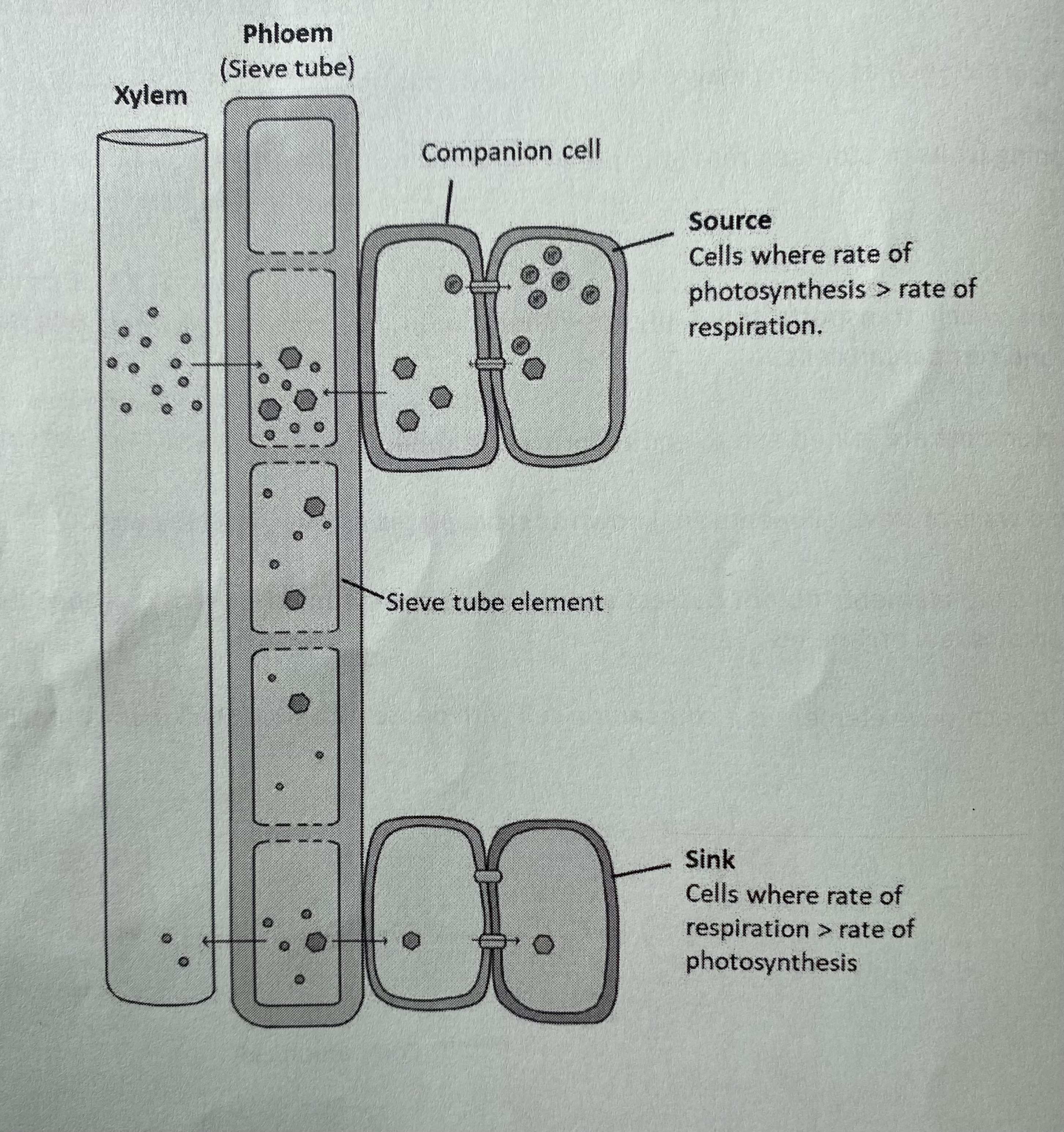
describe the steps of the process of translocation in the phloem
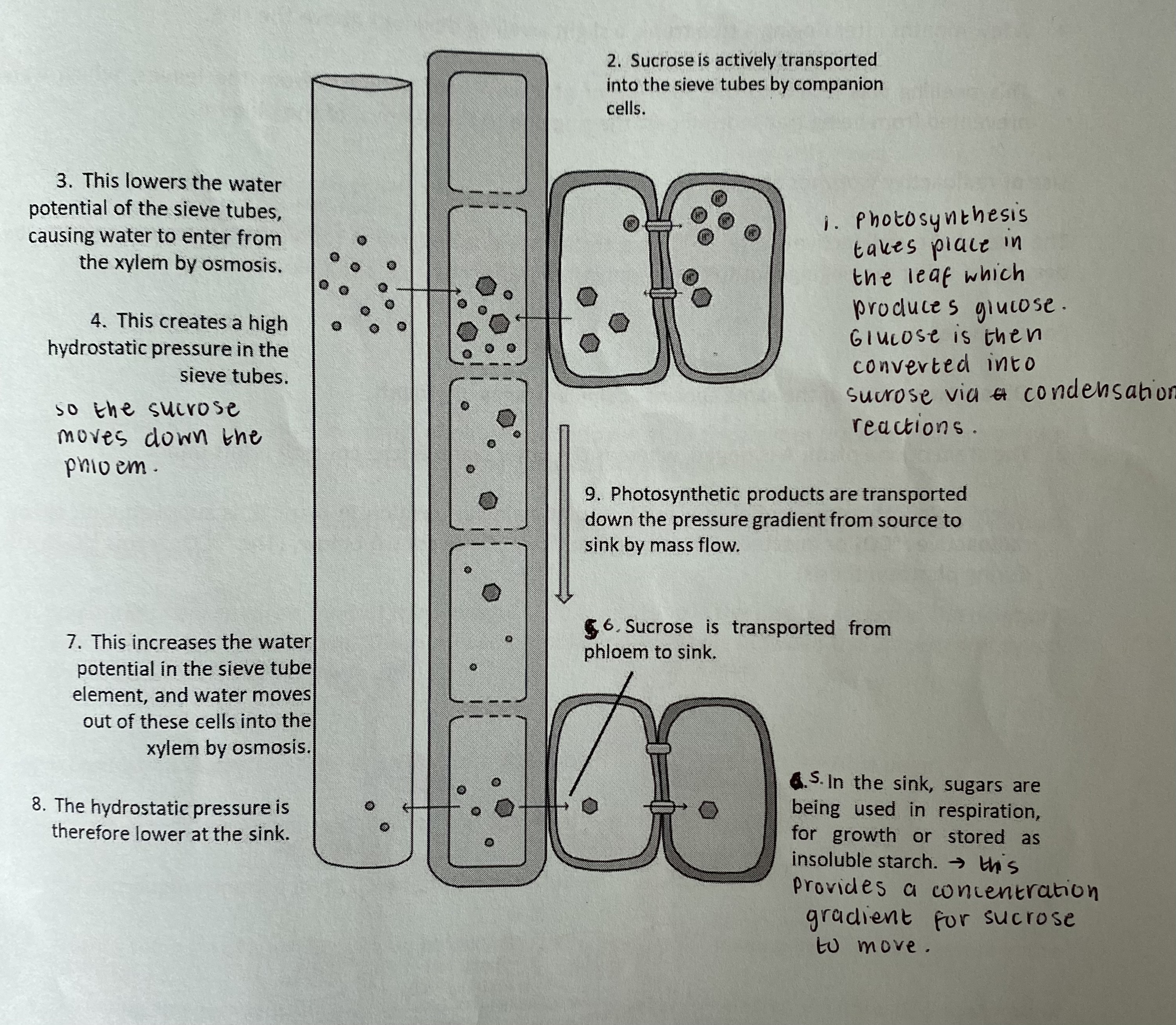
what provided the first evidence that translocation occurs in the phloem?
ringing experiments
what does ringing (also known as girdling) involve?
it involves removing a complete ring of phloem around part of a plant (usually the stem) preventing transport through the phloem at this point
describe the experiment that uses ringing to show the transport of photosynthetic products in the phloem
the first experiments using ringing involved the removal of a complete ring of phloem from the trunk of a tree during summer
a few months after ringing a tree trunk, a slight swelling develops above the ring
this swelling was linked to the build-up of photosynthetic products (sugars) from the leaves, which were prevented from being transported past the ring due to removal of the phloem
what has enabled more sophisticated experiments to be developed using the ringing method to demonstrate translocation in the phloem?
the use of the radioactive isotope ¹⁴C as a tracer
describe the steps + findings of the method of using the radioactive isotope ¹⁴C as a tracer to demonstrate translocation in the phloem
obtain two plants of the same species at similar stages of growth
the stem of one plant, A, is ringed whereas the other, B, (the control) is left intact
a leaf below the ring (girdle) in plant A, + at a similar position in plant B, is supplied with either radioactive ¹⁴CO₂ or injected with radioactive ¹⁴C₆H₁₂O₆ (the ¹⁴CO₂ forms ¹⁴C₆H₁₂O₆ during photosynthesis)
the plants are left for a few hours in sunlight
the transport of the radioactively labelled photosynthetic products can be detected using a process called autoradiography
autoradiography involves placing each plant between X-ray (or photographic) film → the film is then exposed by the radioactively labelled compounds showing their location
the control plant B shows transport of photosynthetic products throughout the plant particularly to the growing regions (shoot tips, young leaves + storage areas)
photosynthetic products cannot be transported in the phloem past the ring + therefore remain below this point
sometimes very small amount of these products do appear above the ring (shown in diagram) due to transport in the xylem → this is a result of lateral transport between xylem + phloem tissue below the ring
(autodiagrams for plants A + B shown in image)
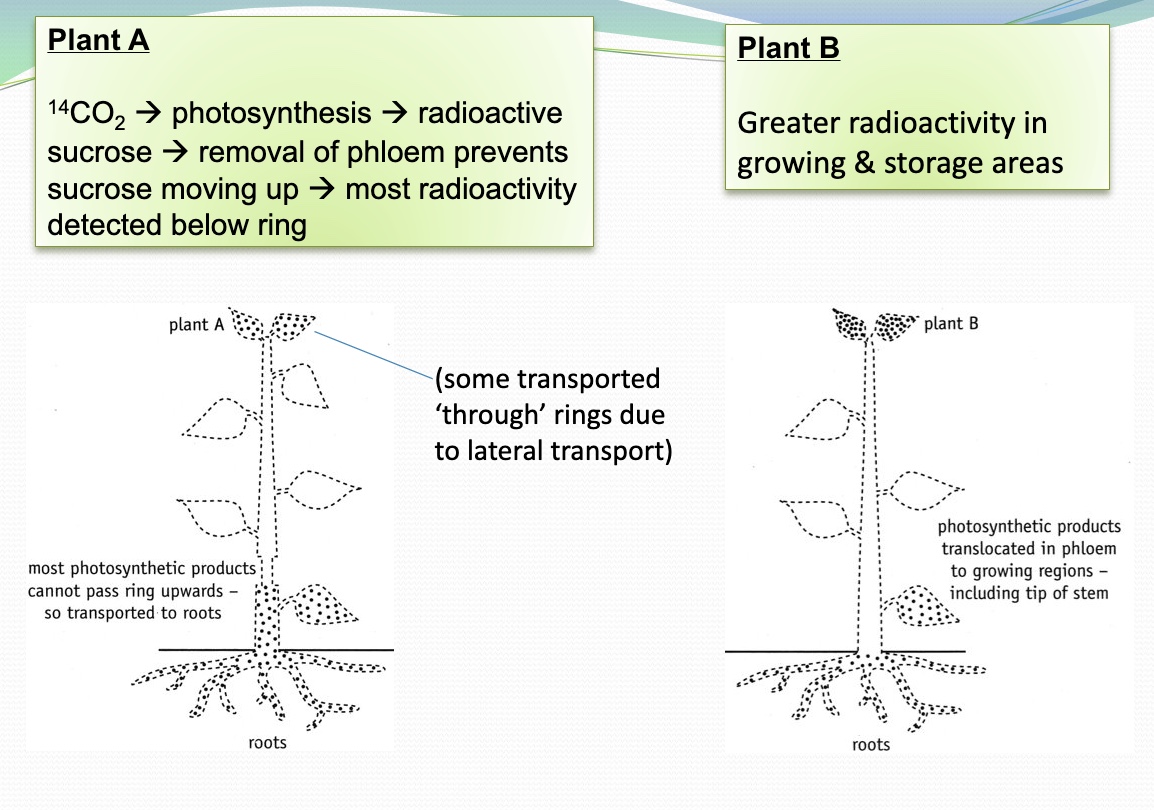
explain two pieces of evidence supporting the mass flow hypothesis
cutting the stem of a plant results in phloem sap being released → indicating hydrostatic pressure in the sieve tubes
lowering the temperature or the use of respiratory inhibitors reduces the rate of translocation → indicating an active transport mechanism is involved (respiratory inhibitors stop translocation of organic solutes when applied to phloem but not when applied to xylem)
explain two pieces of evidence against the mass flow hypothesis
the specific structure of sieve tubes + sieve plates is not required for mass flow
in young phloem tissue, substances have been observed moving in opposite directions in the same sieve tube
how has a combination of microscopy + autoradiography (microautoradiography) also demonstrated evidence for translocation in the phloem?
microautoradiography has demonstrated that sucrose + amino acids are transported in the sieve tube elements rather than in any other cells of the phloem
explain how aphids can be used as evidence for phloem as the tissue for translocation
aphids feed on plant tissues by penetrating the outer layers of the stem + inserting their stylets into the phloem
a feeding aphid may be anaesthetised with carbon dioxide + have its body removed → the mouthparts remain attached to the plant + act as tubes through which the contents of the sieve tubes continue to be forced by hydrostatic pressure
this confirms the presence of carbohydrates + amino acids in the phloem contents